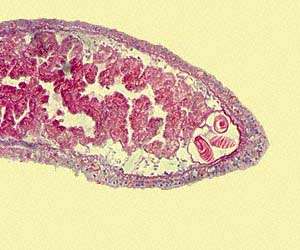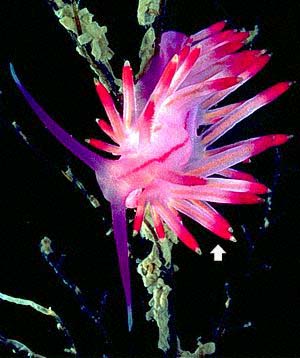

Aeolid cnidosac
PHOTO
Upper: Section through the ceras of Aeolidiopsis ransoni showing the cnidosac with three nematocysts. Lower: Flabellina rubrolineata showing the red band marking the position of the cnidosac in each ceras. Nelson Hd, Port Stephens, New South Wales, September 1981. PHOTOS: Bill Rudman.
The aeolid cnidosac is one of the most remarkable examples of recycling in the animal kingdom. These animals eat cnidarians and are then able to retain, at least some of the stinging cells (nematocysts},from the cnidarian, in a functional state so that they are able to reuse them in their own defence. See Glaucus atlanticus for an example of a nudibranch that can severely sting humans.
Cnidarians or coelenterates (sea anemones, corals, hydroids, jellyfish etc) have a wide range of nematocysts, some of which are used for poisoning prey, some for catching by harpoon-shaped barbs, others for entrapping with sticky secretions or entangling coils. The three nematocysts in the cnidosac photo above are barbed nematocysts. When they are triggered the spiral thread, which is easily seen in the photo, uncoils as a long thread, to attach the barb to the cnidarian, or in this case, to the cnidosac.
It is now thought that nematocysts reach a state of physical but not physiological maturity in the cnidarian. Usually, after some time, they then become part of the cnidarian's functional armoury. It is thought that the nematocysts which are captured and able to be used by the aeolids are those that are physically mature when eaten, but not yet physiologically mature.
See References to research on cnidosacs & nematocysts.
See Defence in sea slugs for links to other pages on this topic.
Rudman, W.B., 1998 (October 14) Aeolid cnidosac. [In] Sea Slug Forum. Australian Museum, Sydney. Available from http://www.seaslugforum.net/factsheet/defcnid
Related messages
-
Nudibranchs and cnidarian nematocysts
From: Charlie Ellis, February 15, 2005 -
Nudibranch Predation Experiment
From: Rosemary Romero, July 15, 2003 -
Sea slugs and nematocysts
From: Asa, November 26, 2002 -
Re: Nudibranch/Nematocyst interaction
From: Chad Sisson, July 9, 2000 -
Nudibranch/Nematocyst interaction
From: Annie Lindgren, July 7, 2000 -
References on defensive function of nematocysts
From: Dave Piatek, February 25, 2000
